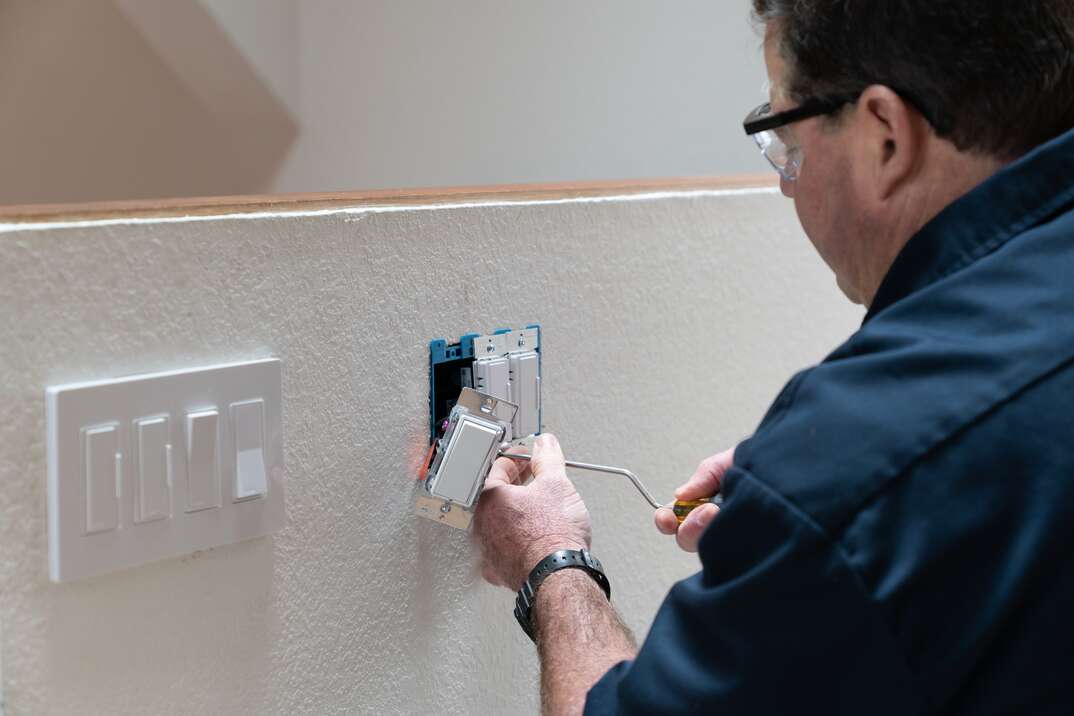Have you ever wondered how you can control a light fixture from two different locations in your home? For example, you may have a hallway or a stairway that has a switch at each end, so you can turn the light on or off from either side. This is possible thanks to a special type of switch called a three-way switch.
In this article, we will explain how a three-way switch works. Continue reading!

Table of contents
What is a Three-Way Switch?
A three-way switch is different from a regular single-pole switch, which has only two terminals and one position (on or off). A three-way switch has three terminals and two positions (up or down).
The terminals are usually labeled as common ©, traveler A (TA), and traveler B (TB). The common terminal is connected to either the power source or the light fixture, depending on the wiring configuration. The traveler terminals are connected to each other through another three-way switch.
See also: How to Do Home Electrical Repairs on Your Own: Full Guide
How Does a Three-Way Switch Work?
The way a three-way switch works is that it allows the current to flow through one of the two traveler wires, depending on the position of the switch.
When both switches are in the same position (up or down), the current flows through one traveler wire and completes the circuit, turning the light on.
When the switches are in opposite positions, the current flows through the other traveler wire and breaks the circuit, turning the light off.

See also: How Drywall Works | Full Guide and Details
Ways to Wire a Three-Way Switch
There are two common ways to wire a three-way switch: the power-through switch method and the light fixture between switches method. Let’s take a look at each one in detail.
Power-Through Switch Method
In this method, the power source is connected to the common terminal of the first switch. The traveler wires are connected to the traveler terminals of both switches. The common terminal of the second switch is connected to the light fixture. The diagram below shows how this looks like.

To understand how this works, let’s follow the path of the current. When both switches are in the up position, the current flows from the power source to the common terminal of the first switch, then through the traveler A wire to the traveler A terminal of the second switch, then through the common terminal of the second switch to the light fixture, and then back to the power source through the neutral wire. The light is on.
More Explanations
When one of the switches is flipped to the down position, the current flows from the power source to the common terminal of the first switch, then through the traveler B wire to the traveler B terminal of the second switch, then through the common terminal of the second switch to the light fixture, and then back to the power source through the neutral wire. The light is still on.
When both switches are flipped to the down position, the current flows from the power source to the common terminal of the first switch, then through the traveler B wire to the traveler B terminal of the second switch, then through the traveler A wire to the traveler A terminal of the first switch, and then back to the power source through the neutral wire. The circuit is broken and the light is off.
When one of the switches is flipped back to the up position, the current flows from the power source to the common terminal of the first switch, then through the traveler A wire to the traveler A terminal of the second switch, then through the traveler B wire to the traveler B terminal of the first switch, and then back to the power source through the neutral wire. The circuit is broken and the light is still off.
As you can see, the light is controlled by the combination of the positions of the two switches, not by the individual position of each switch.
See also: How Do Stud Finders Work?
Light Fixture Between Switches Method
In this method, the power source is connected to the light fixture, and the switches are connected to each other through the traveler wires. The common terminals of both switches are connected to the hot wire of the light fixture. The diagram below shows how this looks like.

To understand how this works, let’s follow the path of the current. When both switches are in the up position, the current flows from the power source to the hot wire of the light fixture, then through the common terminal of the first switch, then through the traveler A wire to the traveler A terminal of the second switch, then through the common terminal of the second switch, and then back to the power source through the neutral wire of the light fixture. The light is on.
When one of the switches is flipped to the down position, the current flows from the power source to the hot wire of the light fixture, then through the common terminal of the first switch, then through the traveler B wire to the traveler B terminal of the second switch, then through the common terminal of the second switch, and then back to the power source through the neutral wire of the light fixture. The light is still on.
More Explanations
When both switches are flipped to the down position, the current flows from the power source to the hot wire of the light fixture, then through the common terminal of the first switch, then through the traveler B wire to the traveler B terminal of the second switch, then through the traveler A wire to the traveler A terminal of the first switch, and then back to the power source through the neutral wire of the light fixture. The circuit is broken and the light is off.
When one of the switches is flipped back to the up position, the current flows from the power source to the hot wire of the light fixture, then through the common terminal of the first switch, then through the traveler A wire to the traveler A terminal of the second switch, then through the traveler B wire to the traveler B terminal of the first switch, and then back to the power source through the neutral wire of the light fixture. The circuit is broken and the light is still off.
As you can see, the light is controlled by the combination of the positions of the two switches, not by the individual position of each switch.
See also: How Does a Master Key Work on Various Doors?
Tips for Wiring a Three-Way Switch
Wiring a three-way switch can be a bit tricky, but with some patience and attention to detail, you can do it yourself. Here are some tips to help you along the way:
- Always turn off the power at the breaker box before working on any electrical wiring.
- Use a voltage tester to make sure the wires are not live before touching them.
- Use wire strippers to strip about 3/4 inch of insulation from the ends of the wires.
- Use wire nuts to connect the wires together, following the color coding: black to black, white to white, and green or bare to green or bare. The traveler wires can be any color, but usually, they are red and black.
- Use a screwdriver to attach the wires to the terminals of the switches, following the labels: common to common, traveler A to traveler A, and traveler B to traveler B. Make sure the screws are tight and the wires are secure.
- Use electrical tape to wrap around the wire nuts and the terminals of the switches for extra insulation and safety.
- Use a multimeter to test the continuity of the circuit and the functionality of the switches. If the light does not turn on or off as expected, check the wiring connections and the positions of the switches.
- Use a drill and screws to mount the switches and the light fixture to the wall or ceiling boxes. Make sure the switches are aligned and level.
- Turn on the power at the breaker box and enjoy your new three-way lights.
See also: How Stamped Concrete Works
3-Way Switch Troubleshooting
To troubleshoot a 3-way switch, you need to test both switches and the wiring connections. You can use a continuity tester or a multimeter to check the continuity between the terminals of each switch. You can also use a voltage tester to check the power supply to the switches.
The steps to troubleshoot a 3-way switch are as follows:
- Turn off the power at the circuit breaker and make sure the wires are not live.
- Remove the two 3-way switches from the wall boxes and expose the terminals.
- Use a continuity tester or a multimeter to check the continuity between the common terminal and each of the traveler terminals of each switch. There should be continuity between the common terminal and only one of the traveler terminals, depending on the position of the switch. If there is no continuity or continuity between both traveler terminals, the switch is defective and needs to be replaced.
- Use a voltage tester to check the power supply to the switches. There should be only one live wire connected to the common terminal of one of the switches. If there is no power or power to both switches, the wiring is incorrect and needs to be fixed.
- Replace the defective switch or fix the wiring, and reinstall the switches to the wall boxes. Turn on the power and test the switches. The light should turn on and off from both locations.
See also: How Does Dry Cleaning Work?
FAQs
A common issue with three-way switches is having the traveler wire and common wire mixed up, which could be the culprit. Or the switch could be worn down after significant wear and tear, indicating that it’s time to replace the switch.
If you look closely at them, you’ll see that there’s no on-off marking like you find on a simple switch. That’s because either position can be on or off. “Three-way” means that there are three components in the circuit – two switches and the light(s).
When a light is to be controlled from two different locations, such as the top and bottom of a set of stairs, or a room with more than one entrance, we use a pair of single-pole, double-throw switches to create a 3-way switch loop.
The traveler wires run between the two 3-way switches, offering two potential pathways to complete the circuit and send power onward to the light fixture. It makes no difference which traveler wire goes to which traveler terminal on the switch; the traveler terminals are interchangeable.
Double-checking the wire color is the easiest way to identify travelers. In a three-way configuration, two traveler wires connect to the two lighter-colored brass screws on the switch (known as the traveler screws).
Conclusion
We hope this article has helped you learn more about three-way lights and how three-way switches work.
Three-way switches are a great way to control a light fixture from two different locations in your home. They are not as complicated as they may seem, as long as you understand how they work and how to wire them correctly.
With some basic tools and skills, you can install a three-way switch yourself and save some money on hiring an electrician. However, if you are not confident or comfortable with electrical wiring, it is always best to call a professional for help.
References
- Asktheelectricalguy.com – 3-Way Light Switch Basics
- Thespruce.com – What Is a 3-Way Switch?





